MakerBot, which has been producing desktop 3D printers for years, is introducing its first performance 3D printer, described as “bridging the gap” between desktop and industrial 3D printing. The Method 3D printer offers features previously only available on industrial 3D printers at a much lower cost, using industrial technologies and expertise from parent company Stratasys.
“In an age of disruption, businesses are under pressure to innovate and bring products to market faster. Current desktop 3D printers derive their DNA from hobbyist 3D printers and are insufficient for many applications in the professional segment,” said Nadav Goshen, MakerBot CEO. “We believe that Method is the next step in helping organizations adopt 3D printing at a larger scale. Method provides a breakthrough in 3D printing that enables industrial designers and mechanical engineers to innovate faster and become more agile. It is built for professionals who need immediate access to a 3D printer that can deliver industrial performance to accelerate their design cycles. Method is developed to bring industrial technologies into an accessible platform, breaking the price-performance barrier and redefining rapid prototyping in the process.”
 The Method 3D printer offers a level of precision that has previously only been available with industrial 3D printers: specifically, ± 0.2 mm dimensional accuracy as well as increased vertical layer uniformity and good cylindricity. The printer has dual extruders which, combined with water soluble PVA for supports, allows for excellent surface finish, as well as design freedom and complex geometries such as overhangs without scarring. A streamlined, user-friendly workflow enables users to quickly turn their CAD files into 3D printed parts, and the Method features print speeds that are twice as fast as typical desktop 3D printers. It’s also about a third of the cost of an entry-level industrial 3D printer.
The Method 3D printer offers a level of precision that has previously only been available with industrial 3D printers: specifically, ± 0.2 mm dimensional accuracy as well as increased vertical layer uniformity and good cylindricity. The printer has dual extruders which, combined with water soluble PVA for supports, allows for excellent surface finish, as well as design freedom and complex geometries such as overhangs without scarring. A streamlined, user-friendly workflow enables users to quickly turn their CAD files into 3D printed parts, and the Method features print speeds that are twice as fast as typical desktop 3D printers. It’s also about a third of the cost of an entry-level industrial 3D printer.
Industrial-grade features include a circulating heated chamber, which controls the temperature and quality of each layer by providing full heat immersion during the entire duration of the print. The printed materials then cool at a controlled rate, providing higher dimensional accuracy, layer adhesion and part strength. A new lengthened thermal core is up to 50 percent longer than a standard desktop hot end, enabling faster, smoother extrusion. A rigid metal frame runs the full length of the body of the 3D printer to offset flexing and ensure more consistent prints.
Dry-sealed material bays form a seal to reduce moisture absorption in the filament, and built-in sensors monitor humidity and alert users to any changes in the environment, which is especially useful for water-soluble PVA filament, PA (polyamide) and also PLA. MakerBot offers two categories of materials for the Method 3D printer: Precision and Specialty. Precision Materials include MakerBot Tough, MakerBot PLA, and MakerBot PVA. The first Specialty Material available is PETG, with more to come. A Smart Spool provides information about the filament, such as type, color and amount of material remaining via an RFID chip directly to the software, while desiccant in the spool keeps moisture levels low. Its unclear at this point if this means that the Method is closed or if you can still run non-Stratasys materials on it.
The Method 3D printer also features a spring steel build plate that allows the finished part to pop right off, and a 5″ capacitive touch screen for easy updates and navigation. It uses MakerBot Print software, which easily integrates with 25 of the most popular CAD programs. Teams can also save 3D files as projects and share them via the native Cloud Management platform. A built-in onboard camera allows users to monitor the print remotely with MakerBot Print or the MakerBot Mobile app.
The MakerBot Method 3D printer has been tested by the company for more than 220,000 hours. It has a starting price of €6,499 and shipping is expected to begin in the first quarter of 2019. Pre-orders are now being taken. This system seems an exciting upgrade to the Makerbot lineup putting it below the F123 Stratasys printers. A lot of the features, especially material mateial bays and enclosure, seem to be solid wins for many customers. This would be a good option for companies while being too expensive for most makers. By raising performance and price Makerbot is chasing higher performing printers and the growing desktop enterpise market. This is a very important system for Stratasys and we will be watching the performance and acceptance of this system closely.
Discuss this and other 3D printing topics at 3DPrintBoard.com or share your thoughts below.
Subscribe to Our Email Newsletter
Stay up-to-date on all the latest news from the 3D printing industry and receive information and offers from third party vendors.
Print Services
Upload your 3D Models and get them printed quickly and efficiently.
You May Also Like
3D Printing News Briefs, July 2, 2025: Copper Alloys, Defense Manufacturing, & More
We’re starting off with metals in today’s 3D Printing News Briefs, as Farsoon has unveiled a large-scale AM solution for copper alloys, and Meltio used its wire-laser metal solution to...
3DPOD 260: John Hart on VulcanForms, MIT, Desktop Metal and More
John Hart is a Professor at MIT; he´s also the director of the Laboratory for Manufacturing and Productivity as well as the director of the Center for Advanced Production Technologies....
3D Printing News Briefs, June 28, 2025: Defense Accelerator, Surgical Models, & More
In this weekend’s 3D Printing News Briefs, 3YOURMIND was selected to join an EU Defense Accelerator, and PTC has announced model-based definition (MBD) capabilities within Onshape. Finally, a study out...
EOS in India: AM’s Rising Star
EOS is doubling down on India. With a growing base of aerospace startups, new government policies, and a massive engineering workforce, India is quickly becoming one of the most important...



































